The beautiful natural venues of Virginia in the United States provide a wide variety of different habitats for all kinds of wildlife. From the Appalachian Mountains to the state’s grasslands, forests, and coastal beaches, there is something for everyone. With such a plethora of rich habitats, it’s no wonder that Virginia is home to over 20 different species of snakes! But what about venomous rattlesnakes? Let’s take a closer look at the only rattlesnake in Virginia, the timber rattlesnake!
Timber Rattlesnake (or Canebrake Rattlesnake)

Timber rattlesnakes are only found in two areas of Virginia – in the mountains and the extreme southeastern regions
©Frode Jacobsen/Shutterstock.com
| Range | Mountains of western Virginia, & extreme southeastern regions |
| Length | 36-60 inches |
There are two main areas where timber rattlesnakes live in Virginia: the mountains of western Virginia, and the extreme southeastern regions of the state. In the southeastern portions, these snakes are usually called canebrake rattlesnakes. Some Virginians also called them Virginia rattlesnakes and banded rattlesnakes.
Rattlesnakes in these southeastern areas prefer areas with mixed or mature hardwood and pine forests, ridges and glades near swampy areas, and cane thickets. Timber rattlesnakes in the western regions of Virginia also prefer densely wooded areas, along with talus slopes and rocky outcroppings.
During the summer, timber rattlesnakes often spend time in more open areas like grass and farm fields, basking in the sun and hunting for food. When winter comes the snakes return to their ancestral dens underground and in rock crevices, or burrow into hollow stumps and trees. Throughout winter rattlesnakes brumate, a process somewhat like hibernation but not nearly as heavy.
A 1993 survey revealed that timber rattlesnakes in Virginia have lost at least 55% of their original range in the state and are expected to lose at least 36% more due to residential and commercial development. As such, timber rattlesnakes in Virginia are endangered and protected by state laws. In addition to human development, these snakes are also threatened by habitat fragmentation and human persecution.
Appearance
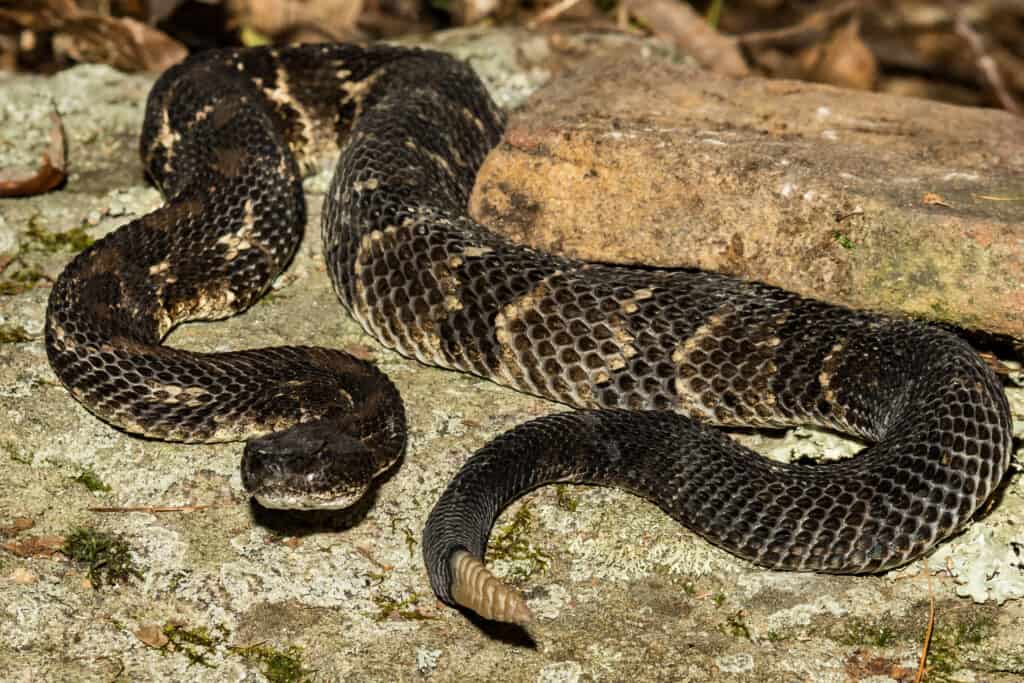
Black phase Timber Rattlesnakes have dark speckles all over their bodies that make them look much darker.
©iStock.com/JasonOndreicka
Virginia’s timber rattlesnakes may be yellow, gray, light brown, pinkish, or even almost black. Dark zigzag or chevron patterned bands cover their bodies and end with black tails tipped with a large rattle. Some snakes also have an additional rust-colored stripe in the middle of their backs, as well as a yellow, gold, or brown stripe that runs from each eye to the back of the snake’s jaw.
While you may come across snakes with a combination of these characteristics, in general, there are three main color phases of timber rattlesnakes in Virginia:
- Black Phase: These rattlesnakes have black heads and chevron patterns on a dark colored body. Some snakes may appear almost entirely black as well. Black phase timber rattlesnakes are typically only found in the western parts of their range in Virginia.
- Yellow Phase: These rattlesnakes have yellow heads with black or dark brown chevron patterns on a yellowish-brown body. Yellow phase timber rattlesnakes are typically only found in the western parts of their range in Virginia.
- Canebrake Phase: These rattlesnakes have black or dark-brown chevron patterns on a light-tan to pinkish colored body. They also have a brown or rust-colored stripe along their spines.
Behavior
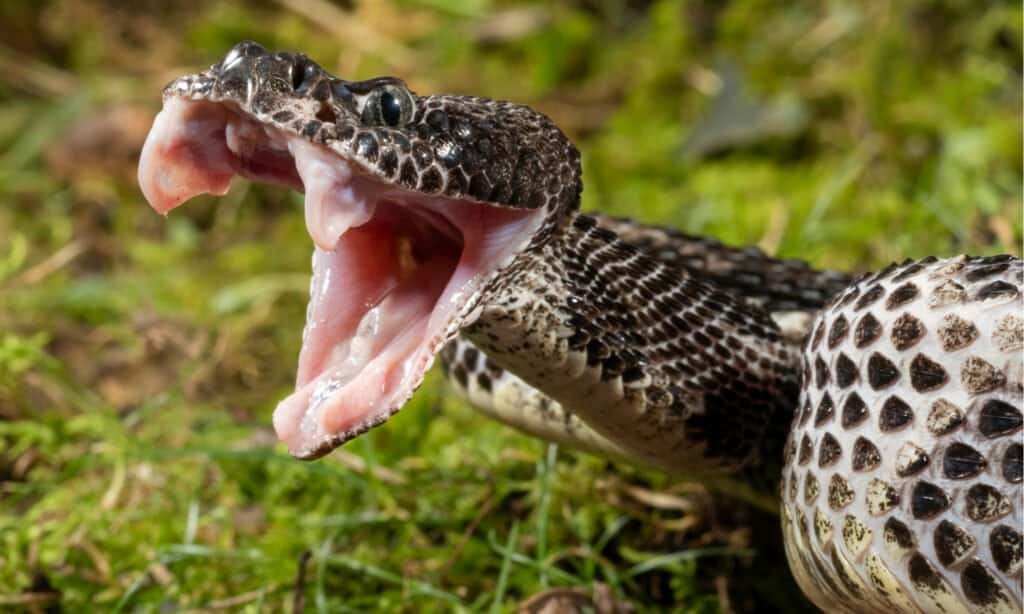
Although they are highly venomous, timber rattlesnakes are actually shy and not prone to striking without reason
©Joe McDonald/Shutterstock.com
Timber rattlesnakes are ambush predators that patiently wait for their prey to come close enough for an attack. In Virginia they commonly eat mammals and rodents like gray squirrels, mice, voles, woodrats, chipmunks, rabbits, lemmings, and shrews. Occasionally they also hunt birds, but not as often. Although they are venomous and dangerous animals, timber rattlesnakes – particularly the smaller and younger ones – are sometimes killed by deer, dogs, hogs, sheep, chickens, turkeys, and red-tailed hawks. However, the greatest threats to timber rattlesnakes are humans, many of whom often purposely seek them out and persecute them.
Timber rattlesnakes have a toxic venom and due to their large size, they can potentially inject a lot of it into a single bite. However, these snakes are not known to be aggressive, and are usually shy and secretive. Timber rattlesnakes only strike if they are handled or feel threatened. If you come near a timber rattlesnake, it will likely shake its rattle loudly in warning long before striking.
However, some timber rattlesnakes prefer to hide from threats and will stay quiet. The greatest risk with these snakes is potentially stepping on one that is especially well-camouflaged among the forest debris and leaves. As timber rattlesnakes are endangered and protected by state laws, it is illegal to try to catch or injure one of these snakes.
Other Snakes in Virginia
The timber rattlesnake is Virginia’s only rattlesnake species, and generally is easy to identify due to its large rattle. However, juvenile rattlesnakes have only a button or a few small segments of a rattle, and rattles can break off from time to time. Because of this, sometimes other snake species in Virginia are mistaken for timber rattlesnakes. Here are a few examples:
Northern Water Snake
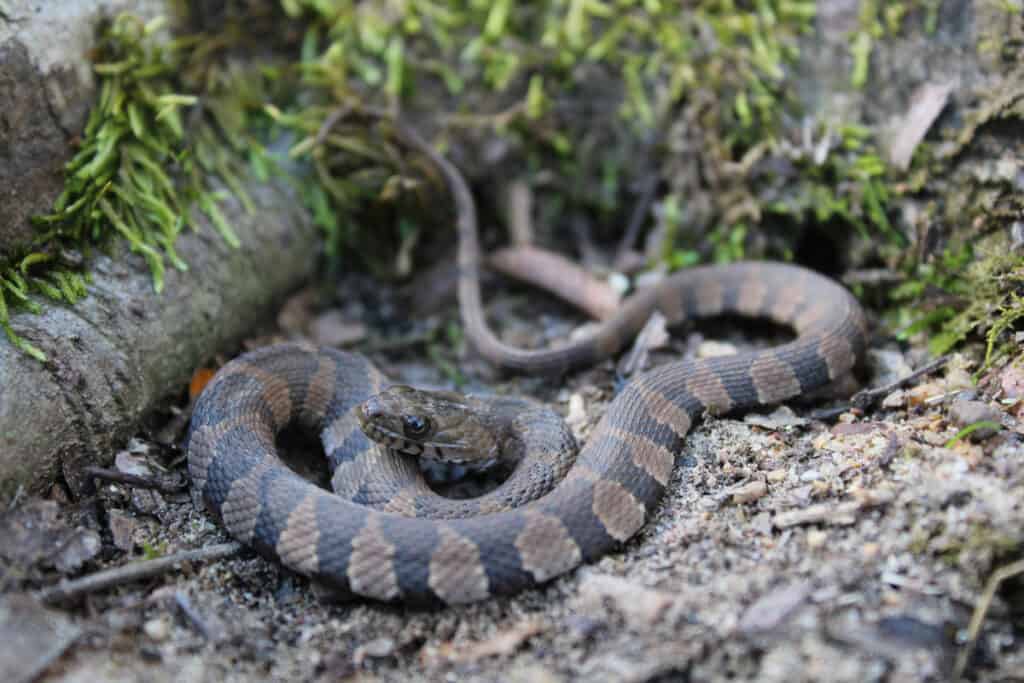
Northern water snakes are sometimes mistaken for timber rattlesnakes
©Tucker Heptinstall/Shutterstock.com
| Range | All of Virginia |
| Length | 24-42 inches |
These snakes live all over Virginia in and near areas with water. They are usually 24 to 42 inches long, with gray to brown bodies with different levels of white, yellow, or red coloring. Reddish-brown to black blotches and crossbands line their backs, and their bellies are pinkish, yellowish, or cream. You may encounter northern water snakes in ponds, lakes, creeks, swamps, ditches, marshes, and wetlands areas. They are not venomous, but they can be quick to anger and bite repeatedly.
Brown Water Snake
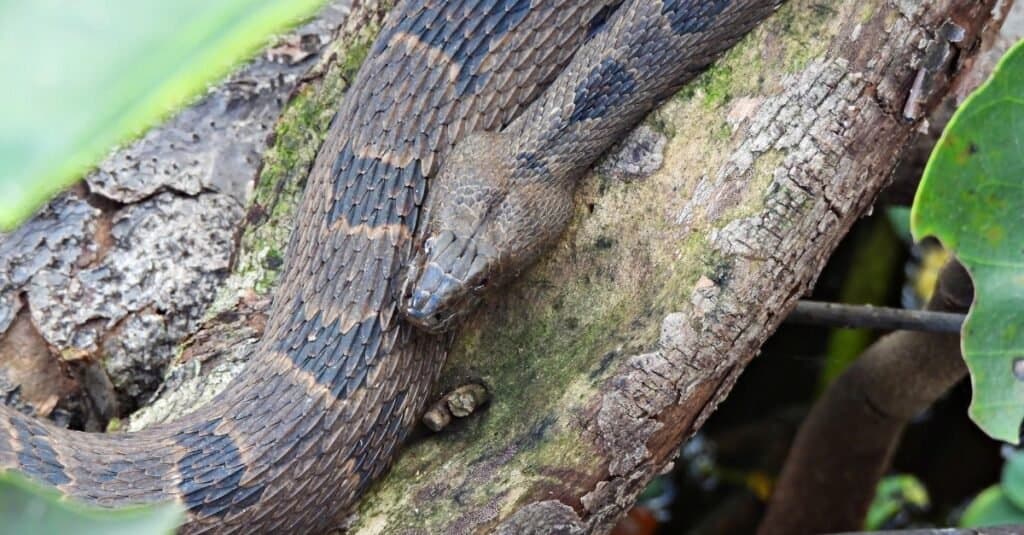
Brown water snakes only live in the southeast region of Virginia.
©iStock.com/passion4nature
| Range | Southeastern corner of Virginia |
| Length | 30-60 inches |
Another water snake that lives in Virginia is the brown water snake. However, these snakes only live in the southeast corner of the state. They typically grow between 30-60 inches in length, and the longest in Virginia was 68.7 inches long. They have heavy brown bodies with dark brown or black blotches along their backs and sides. Brown water snakes prefer living in larger bodies of water, like reservoirs, rivers, and marshes around bays.
Plain-Bellied Water Snake
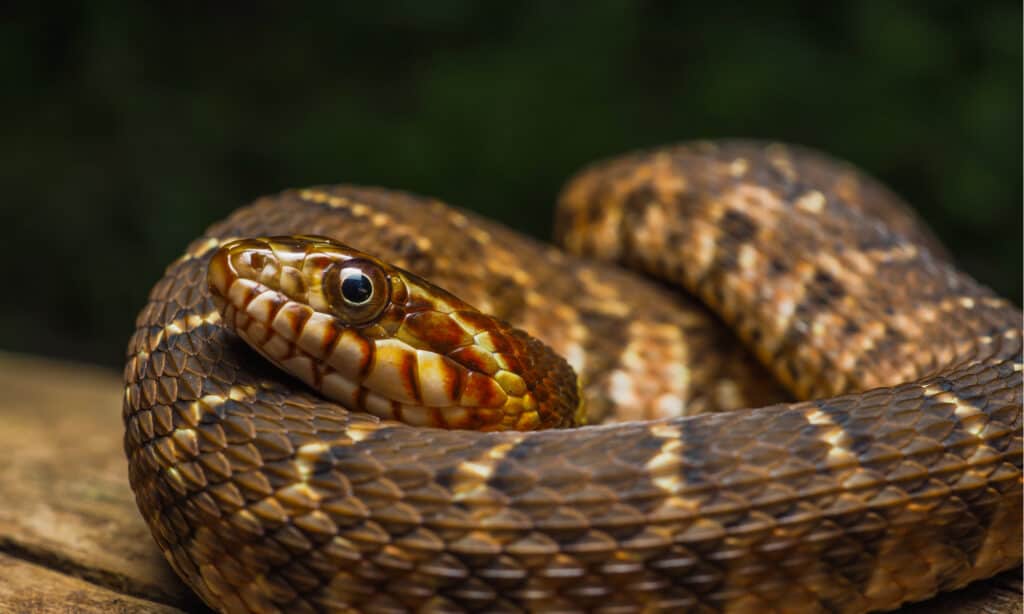
Plain-bellied water snakes typically live in areas such as swamps, streams, and ditches
©Tyler Albertson/Shutterstock.com
| Range | Southeast corner of Virginia |
| Length | 30-48 inches |
The third water snake in Virginia is the plain-bellied water snake, which prefers vegetative habitats like swamps, freshwater marshes, ditches, streams, and fields with drainage ditches. Like brown water snakes, plain-bellied water snakes live only in the southeast corner of Virginia. They typically grow between 30 and 48 inches long. Their bodies are reddish-brown, with dark brown heads. There is a very distinct contrast between the snake’s back and belly, which varies in color from yellowish orange to orange or red.
Eastern Rat Snake
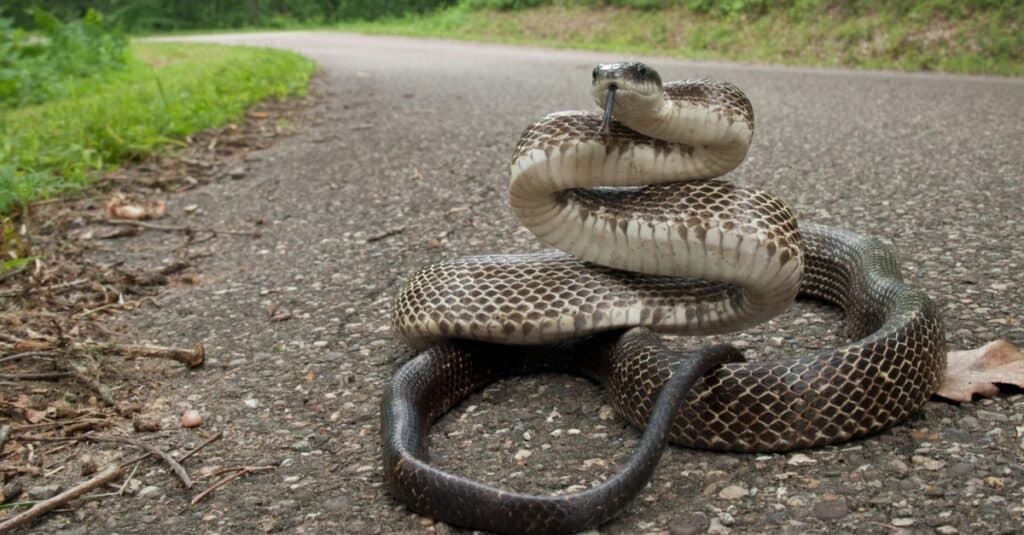
When threatened, rat snakes will “rattle” their tail, fooling other animals into believing they are venomous.
©Mike Wilhelm/Shutterstock.com
| Range | All of Virginia |
| Length | 42-72 inches |
Found all throughout the state of Virginia, the eastern rat snake is a large snake that usually grows between 42 and 72 inches in length. Eastern rat snakes are some of the most common snakes encountered in Virginia, and often spend time both on the ground as well as in trees. They live in many different types of habitats, like agricultural areas, urban woodlots, hardwood forests, forested wetlands, and in old buildings and barns where there are plenty of rodents to hunt. Adult snakes have solid black bodies with white necks and bellies. Juvenile eastern rat snakes, however, are commonly mistaken for rattlesnakes, because they have dark blotches on brown or gray bodies. Their bellies have a brown and white checkerboard-like pattern.
Northern Pine Snake
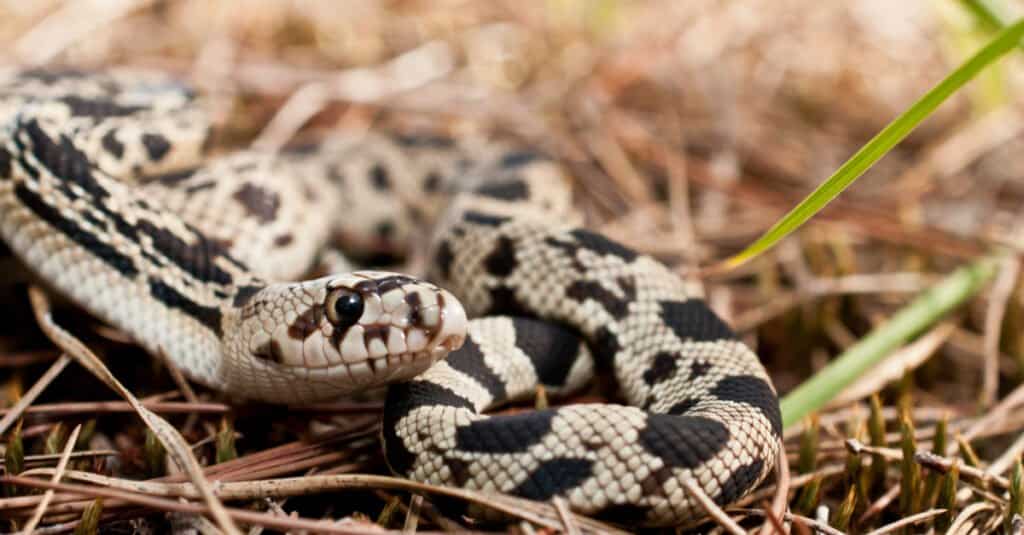
The spots on a pine snake are generally darker towards the head and lighter towards the tail.
©Jay Ondreicka/Shutterstock.com
| Range | Augusta, Craig, Bath, and Botetourt Counties in Virginia |
| Length | 48-66 inches |
These snakes are secretive and like to burrow, so they are not commonly seen in Virginia. They have only been encountered in Augusta, Craig, Bath, and Botetourt counties. Reports suggest that they are most likely to live in dry, open habitats on ridges, hills, and mountain slopes with sandy substrate. Northern pine snakes grow between 48 and 66 inches in length and are white, cream, yellow, or light brown, with irregular dark blotches running down their backs. Juvenile snakes are white with black blotches.
Up Next:
- 24 Snakes in Virginia
- When do snakes come out in Virginia?
- When Do Rattlesnakes Lose their Rattles?
- Viper Pits: The Incredible “Sixth Sense” that Lets Vipers Hunt in Infrared
The photo featured at the top of this post is © Frode Jacobsen/Shutterstock.com
Discover the "Monster" Snake 5X Bigger than an Anaconda
Every day A-Z Animals sends out some of the most incredible facts in the world from our free newsletter. Want to discover the 10 most beautiful snakes in the world, a "snake island" where you're never more than 3 feet from danger, or a "monster" snake 5X larger than an anaconda? Then sign up right now and you'll start receiving our daily newsletter absolutely free.
Sources
- Virginia Herpetological Society, Available here: https://www.virginiaherpetologicalsociety.com/reptiles/snakes/snakes_of_virginia.html
- Virginia Herpetological Society, Available here: https://www.virginiaherpetologicalsociety.com/reptiles/snakes/timber-rattlesnake/timber_rattlesnake1.php
- Virginia DWR, Available here: https://dwr.virginia.gov/wildlife/nuisance/snakes/
- Virginia DWR, Available here: https://dwr.virginia.gov/wp-content/uploads/media/Canebrake-Rattlesnake-Information-Sheet.pdf
Thank you for reading! Have some feedback for us? Contact the AZ Animals editorial team.






